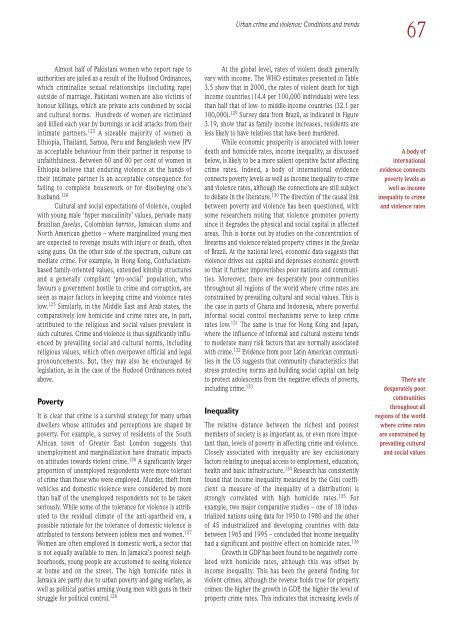Download the file - United Nations Rule of Law
Download the file - United Nations Rule of Law
Download the file - United Nations Rule of Law
- No tags were found...
Create successful ePaper yourself
Turn your PDF publications into a flip-book with our unique Google optimized e-Paper software.
Urban crime and violence: Conditions and trends67Almost half <strong>of</strong> Pakistani women who report rape toauthorities are jailed as a result <strong>of</strong> <strong>the</strong> Hudood Ordinances,which criminalize sexual relationships (including rape)outside <strong>of</strong> marriage. Pakistani women are also victims <strong>of</strong>honour killings, which are private acts condoned by socialand cultural norms. Hundreds <strong>of</strong> women are victimizedand killed each year by burnings or acid attacks from <strong>the</strong>irintimate partners. 123 A sizeable majority <strong>of</strong> women inEthiopia, Thailand, Samoa, Peru and Bangladesh view IPVas acceptable behaviour from <strong>the</strong>ir partner in response tounfaithfulness. Between 60 and 80 per cent <strong>of</strong> women inEthiopia believe that enduring violence at <strong>the</strong> hands <strong>of</strong><strong>the</strong>ir intimate partner is an acceptable consequence forfailing to complete housework or for disobeying one’shusband. 124Cultural and social expectations <strong>of</strong> violence, coupledwith young male ‘hyper masculinity’ values, pervade manyBrazilian favelas, Colombian barrios, Jamaican slums andNorth American ghettos – where marginalized young menare expected to revenge insults with injury or death, <strong>of</strong>tenusing guns. On <strong>the</strong> o<strong>the</strong>r side <strong>of</strong> <strong>the</strong> spectrum, culture canmediate crime. For example, in Hong Kong, Confucianismbasedfamily-oriented values, extended kinship structuresand a generally compliant ‘pro-social’ population, wh<strong>of</strong>avours a government hostile to crime and corruption, areseen as major factors in keeping crime and violence rateslow. 125 Similarly, in <strong>the</strong> Middle East and Arab states, <strong>the</strong>comparatively low homicide and crime rates are, in part,attributed to <strong>the</strong> religious and social values prevalent insuch cultures. Crime and violence is thus significantly influencedby prevailing social and cultural norms, includingreligious values, which <strong>of</strong>ten overpower <strong>of</strong>ficial and legalpronouncements. But, <strong>the</strong>y may also be encouraged bylegislation, as in <strong>the</strong> case <strong>of</strong> <strong>the</strong> Hudood Ordinances notedabove.PovertyIt is clear that crime is a survival strategy for many urbandwellers whose attitudes and perceptions are shaped bypoverty. For example, a survey <strong>of</strong> residents <strong>of</strong> <strong>the</strong> SouthAfrican town <strong>of</strong> Greater East London suggests thatunemployment and marginalization have dramatic impactson attitudes towards violent crime. 126 A significantly largerproportion <strong>of</strong> unemployed respondents were more tolerant<strong>of</strong> crime than those who were employed. Murder, <strong>the</strong>ft fromvehicles and domestic violence were considered by morethan half <strong>of</strong> <strong>the</strong> unemployed respondents not to be takenseriously. While some <strong>of</strong> <strong>the</strong> tolerance for violence is attributedto <strong>the</strong> residual climate <strong>of</strong> <strong>the</strong> anti-apar<strong>the</strong>id era, apossible rationale for <strong>the</strong> tolerance <strong>of</strong> domestic violence isattributed to tensions between jobless men and women. 127Women are <strong>of</strong>ten employed in domestic work, a sector thatis not equally available to men. In Jamaica’s poorest neighbourhoods,young people are accustomed to seeing violenceat home and on <strong>the</strong> street. The high homicide rates inJamaica are partly due to urban poverty and gang warfare, aswell as political parties arming young men with guns in <strong>the</strong>irstruggle for political control. 128At <strong>the</strong> global level, rates <strong>of</strong> violent death generallyvary with income. The WHO estimates presented in Table3.5 show that in 2000, <strong>the</strong> rates <strong>of</strong> violent death for highincome countries (14.4 per 100,000 individuals) were lessthan half that <strong>of</strong> low- to middle-income countries (32.1 per100,000). 129 Survey data from Brazil, as indicated in Figure3.19, show that as family income increases, residents areless likely to have relatives that have been murdered.While economic prosperity is associated with lowerdeath and homicide rates, income inequality, as discussedbelow, is likely to be a more salient operative factor affectingcrime rates. Indeed, a body <strong>of</strong> international evidenceconnects poverty levels as well as income inequality to crimeand violence rates, although <strong>the</strong> connections are still subjectto debate in <strong>the</strong> literature. 130 The direction <strong>of</strong> <strong>the</strong> causal linkbetween poverty and violence has been questioned, withsome researchers noting that violence promotes povertysince it degrades <strong>the</strong> physical and social capital in affectedareas. This is borne out by studies on <strong>the</strong> concentration <strong>of</strong>firearms and violence-related property crimes in <strong>the</strong> favelas<strong>of</strong> Brazil. At <strong>the</strong> national level, economic data suggests thatviolence drives out capital and depresses economic growthso that it fur<strong>the</strong>r impoverishes poor nations and communities.Moreover, <strong>the</strong>re are desperately poor communitiesthroughout all regions <strong>of</strong> <strong>the</strong> world where crime rates areconstrained by prevailing cultural and social values. This is<strong>the</strong> case in parts <strong>of</strong> Ghana and Indonesia, where powerfulinformal social control mechanisms serve to keep crimerates low. 131 The same is true for Hong Kong and Japan,where <strong>the</strong> influence <strong>of</strong> informal and cultural systems tendsto moderate many risk factors that are normally associatedwith crime. 132 Evidence from poor Latin American communitiesin <strong>the</strong> US suggests that community characteristics thatstress protective norms and building social capital can helpto protect adolescents from <strong>the</strong> negative effects <strong>of</strong> poverty,including crime. 133InequalityThe relative distance between <strong>the</strong> richest and poorestmembers <strong>of</strong> society is as important as, or even more importantthan, levels <strong>of</strong> poverty in affecting crime and violence.Closely associated with inequality are key exclusionaryfactors relating to unequal access to employment, education,health and basic infrastructure. 134 Research has consistentlyfound that income inequality measured by <strong>the</strong> Gini coefficient(a measure <strong>of</strong> <strong>the</strong> inequality <strong>of</strong> a distribution) isstrongly correlated with high homicide rates. 135 Forexample, two major comparative studies – one <strong>of</strong> 18 industrializednations using data for 1950 to 1980 and <strong>the</strong> o<strong>the</strong>r<strong>of</strong> 45 industrialized and developing countries with databetween 1965 and 1995 – concluded that income inequalityhad a significant and positive effect on homicide rates. 136Growth in GDP has been found to be negatively correlatedwith homicide rates, although this was <strong>of</strong>fset byincome inequality. This has been <strong>the</strong> general finding forviolent crimes, although <strong>the</strong> reverse holds true for propertycrimes: <strong>the</strong> higher <strong>the</strong> growth in GDP, <strong>the</strong> higher <strong>the</strong> level <strong>of</strong>property crime rates. This indicates that increasing levels <strong>of</strong>A body <strong>of</strong>internationalevidence connectspoverty levels aswell as incomeinequality to crimeand violence ratesThere aredesperately poorcommunitiesthroughout allregions <strong>of</strong> <strong>the</strong> worldwhere crime ratesare constrained byprevailing culturaland social values
















